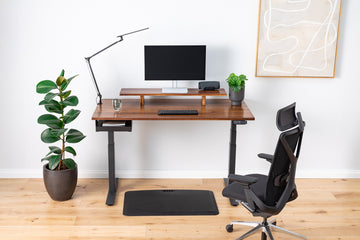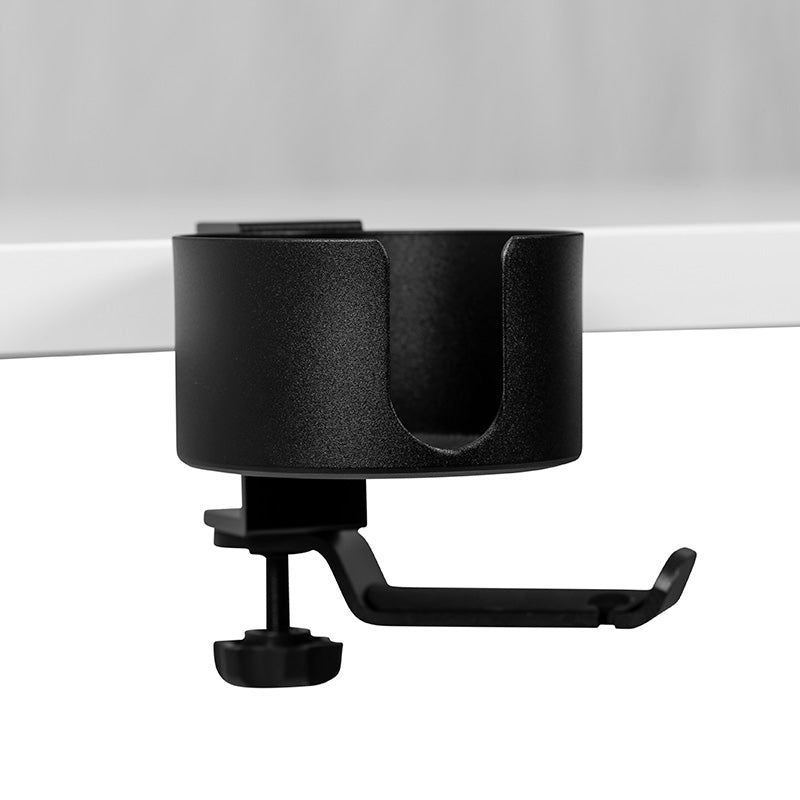A standing desk that refuses to rise can be more than a minor inconvenience. When your desk won’t go up, work is disrupted, focus is lost, and frustration builds quickly. This guide shows you why your desk won’t rise and gives fast steps to fix it.
You’ll find step-by-step fixes for the most common causes, including power problems, cable issues, weight overload, control box errors, and safety stops. If your desk goes down but won’t rise, or stops halfway, this guide also covers those cases.
The goal is to provide practical solutions that anyone can follow at home or in the office. By the end, you’ll know what to check first, how to reset your desk, and when professional help might be necessary.
Quick Reference Table - Identify and Resolve Issues Fast
This quick guide helps you identify problems at a glance. If one solution doesn’t work, continue through the list until your desk operates normally.
| Cause | Why It Happens | How to Fix |
| Object blocking the desk | An item on top or underneath prevents safe movement | Remove the object and try raising the desk again |
| Uneven legs | Desk assembled incorrectly or legs shifted over time | Re-level legs and tighten frame screws |
| Lost power | Power cable unplugged, tripped circuit, or faulty outlet | Reconnect the power, try a different outlet, and reset the desk |
| Loose cables | Motor or control box cables shaken loose during use | Unplug, re-seat all cables firmly, and check for damage |
| Control box error | Desk memory or motorcycle stuck | Perform full reset using the control panel |
| Upper container stop | The desk is programmed with an incorrect max height | Adjust the stop setting or reset the factory defaults |
| Overloaded desk | Weight exceeds the desk’s lifting capacity | Remove excess items until within the weight limit |
What to Do First If Your Standing Desk Won’t Go Up – Quick Fix
Before diving into detailed troubleshooting, start with the simplest checks. Many standing desk problems come from basic issues that can be solved in a minute or two. Begin by removing anything heavy sitting on the desk.
Extra monitors, printers, or stacks of documents may exceed the desk's weight capacity, preventing it from lifting. Clearing the surface helps you rule out overload immediately.
Next, confirm that power is reaching the desk. Verify that the power cord is securely plugged into both the outlet and the control box. Try another outlet if you suspect the circuit has tripped. A desk that looks dead often springs back once the power connection is secure.
Once power is confirmed, inspect all visible cables. Look for loose plugs between the motors and the control box. Re-seating these cables firmly can restore function.
Finally, try a quick reset. Hold the down button until the desk reaches its lowest position, then release. Press down again for a few seconds until you hear a click or slight movement. This simple reset sequence often clears memory or cycle errors.
These steps take under five minutes and solve most cases where a standing desk won’t lift. If your desk still refuses to rise, proceed to the next section for detailed causes and solutions.
Why Your Standing Desk Won’t Go Up (and How to Fix It)
If the quick checks don’t solve the problem, it’s time to examine the underlying causes. A standing desk can stop working for several reasons, ranging from a misplaced object to electronic control errors. Each issue has clear signs that help you identify it quickly and a direct way to fix it.
1. Object on the Desk or in the Way

One of the most common reasons a standing desk refuses to rise is simple: something is blocking it. Desks have built-in safety sensors that prevent movement when they detect resistance.
This could be as obvious as a heavy printer or as subtle as a chair leg wedged under the frame. Even a thick cable pulled tight between the desk and a wall can trigger the stop. If the desk tries to rise but halts immediately, suspect an obstruction.
How to Remove Obstacles Safely
Start by clearing the desktop of heavy or unevenly distributed items. Remove monitors, paperwork, or accessories that might overload one side. Then, check the area under the desk for objects that may be pressing against the frame or legs.
Move chairs, cabinets, or storage boxes away from the base of the unit. Inspect cables and power strips to ensure they are not stretched tight. Once everything is clear, try raising the desk again. If it moves smoothly, the problem is solved. If it still refuses, continue to the next cause.
2. Uneven or Misaligned Legs
If the legs of your standing desk are not aligned, the desk may struggle to move upward. Uneven legs create an imbalance, causing the motors to detect resistance and stop.
This problem often occurs after moving the desk, assembling it incorrectly, or allowing the screws to loosen over time. Signs include one side of the desk lifting slightly while the other side stays put or a tilted work surface that feels unstable.
Fixing Uneven Standing Desk Legs
Begin by lowering the desk completely. Use a level to check if the desktop is flat. If not, tighten the frame screws and adjust the feet until the surface is even. For desks with adjustable glides, rotate the feet until both legs rest firmly on the floor.
Recheck the balance before raising the desk again. If the issue persists, refer to the manufacturer's assembly guide or consult a setup guide for step-by-step adjustments. A balanced frame ensures smooth operation and prevents long-term motor strain.
3. Standing Desk Lost Power
If your standing desk shows no response when you press the controls, the most likely cause is a power issue. Even well-built electric desks rely on a steady connection, and a simple disconnection can stop all movement.
Common reasons include a loose plug, a tripped breaker, or a faulty outlet. Sometimes, after moving the desk, the cord slips out slightly from the control box, leaving the desk without power.
How to Restore Power Connection
Start by verifying that the power cord is securely connected at both ends. Plug the desk directly into a wall outlet instead of a power board to rule out faulty strips. If the circuit has tripped, reset it before attempting to use it again.
Inspect the connection to the control box closely, as this is where plugs often loosen during adjustments. If your desk remains unresponsive, perform a fundamental reset. Reliable power is essential for safe operation, and restoring it usually returns your desk to full function immediately.
4. Loose or Disconnected Cables
Standing desks rely on a network of cables that link the motors, control box, and switch panel. If even one of these connections becomes loose, the desk may stop rising.
This often happens after moving the desk, repeatedly adjusting its height, or bumping the cords while working underneath. Symptoms include a desk that powers on but doesn’t respond to button commands, or one that moves down but not up.
How to Reconnect Loose Cables Properly
Unplug the desk from the outlet before inspecting cables. Remove the cover from the control box and check that every motor and switch cable is fully seated. Push each connector firmly into place until you hear or feel a click.
Pay special attention to wires that run along the frame, as these can shake loose over time. Once secure, reconnect the desk to power and test the controls. If your cables appear worn or damaged, consider replacing them with parts from the standing desk accessories range to ensure long-term reliability.
5. Control Box Cycle or Error
The control box acts as the brain of your standing desk. When it malfunctions or enters a cycle error, the desk may move in one direction only or stop altogether. These errors often occur after power interruptions, repeated height adjustments, or software glitches. A common sign is the desk lowering but refusing to rise again.
How to Reset the Control Box
A reset usually fixes most control box errors. Lower the desk to its minimum height, then hold the down button for several seconds until you hear a click or feel a slight movement. Release, then press again briefly. This sequence clears memory errors and restores normal function.
If your desk continues to malfunction, review your manufacturer’s reset method or consult the ergonomic desk setup guide for practical advice. Resetting balances the system, keeps both legs in sync, and prevents future errors
6. Desk Reached Upper Container Stop
Most electric standing desks include safety limits that prevent the desktop from rising beyond a certain point. This feature, known as the upper container stop, protects the frame and motor from strain. However, if the stop is set too low, your desk may stop short and give the impression that it won’t go up. Users often encounter this after changing settings unintentionally or during a reset.
How to Adjust Upper Container Settings
Lower the desk slightly, then hold the memory button or height adjustment key (depending on the model) until the display flashes. Adjust the maximum height setting to a level that suits your workspace. Confirm by saving the settings in the control panel.
If you are unsure about the correct process, refer to the product-specific instructions in the electric standing desks collection. Adjusting the stop ensures your desk can reach its full range of motion without triggering unnecessary safety limits.
7. Too Much Weight on the Desk
Every standing desk has a maximum lifting capacity. When that limit is exceeded, the motors detect strain and prevent upward movement to avoid damage. Heavy monitors, desktop computers, or piles of office equipment can easily exceed the safe load. Signs of overload include the desk typically lowering, but failing to rise or stopping partway during the lift.
How to Reduce Desk Load
Check your desk’s manual for the exact weight limit, then review what you currently keep on the surface. Remove unnecessary items, such as printers, heavy speakers, or stacked files. If you frequently alternate between seated and standing work, consider using lighter accessories to minimize strain.
Keep the heaviest equipment near the center to distribute weight evenly. Once you’ve lightened the load, test the desk again. Staying within capacity protects the motors and ensures smooth, long-term performance.
Using a standing desk correctly also matters. Many people wonder if it’s bad to use a standing desk all day, and balancing sitting with standing throughout the day helps reduce strain on both your desk and your body.
Why Standing Desks Get Stuck Going Down (and How to Fix It)

Sometimes a desk lowers but then refuses to move further down, which can be just as frustrating as when it won’t rise. The causes are different but often related to built-in safety stops or electronic errors. Many of the same troubleshooting steps apply, but in this case, you’ll focus on features that prevent a desk from lowering too far or on problems in the control box.
1. Desk Reached Lower Container Stop
Most modern standing desks include a lower container stop, a safety feature that prevents the desk from lowering below a certain point. This setting helps protect objects under the desk or prevent the legs from collapsing too far. However, if the stop is set incorrectly, the desk may halt well before it reaches the seated position, leaving you unable to lower it fully.
How to Adjust Lower Container Settings
Use the control panel to reset the desk’s memory. Hold the down button until the desk reaches its lowest point, then continue holding for a few seconds until you feel a click or movement. This clears the stop and resets the minimum height.
For desks with programmable panels, refer to your manual for instructions on adjusting the settings. Once the lower limit is corrected, your desk should lower smoothly to its full range of motion.
2. Object Blocking the Desk’s Movement
If your standing desk refuses to lower, the problem might be something physically in the way. Objects like storage bins, chair arms, or even misplaced cables can prevent the desk from completing its movement.
Most electric desks include sensors that halt operation when resistance is detected. While this feature prevents damage, it can lead you to think the desk has failed when it’s simply blocked.
Removing Obstructions Under the Desk
Check the space beneath and around the desk frame for obstacles. Look for tangled cords, uneven flooring, or items pushed too close. Clear the area thoroughly, then try lowering the desk again.
If lowering issues persist, review these tips on how to lower standing desks for extra guidance. Keeping the space under your desk clear helps restore function and keeps your workspace safe.
3. Control Box Malfunction or Cycle Out
When a control box malfunctions, the desk may respond inconsistently or stop lowering altogether. These issues often appear after power fluctuations or prolonged heavy use. A cycle error can cause one leg to move while the other stalls, forcing the system to lock for safety.
Resetting or Replacing the Control Box
Start with a reset: hold the down button until the desk reaches its lowest point, then continue holding for several seconds. This action usually clears errors and rebalances the motors. If resetting doesn’t solve the issue, inspect all connected cables for looseness or damage.
Replacement may be necessary if the control box no longer responds to commands. For work setups where downtime is critical, some people prefer a more straightforward solution, such as manual standing desks, which don’t rely on electronic controls. Choosing the right option ensures smoother performance and fewer interruptions in your daily routine.
4. General Desk Malfunction
If your standing desk refuses to move down despite clearing obstacles and checking the control box, the issue may be a broader malfunction. This could involve a faulty motor, damaged wiring, or an internal error that cannot be solved with simple resets. In such cases, following electrical safety practices is essential before calling a technician.
When to Call for Professional Support
If the desk remains stuck after you’ve attempted resets and inspections, it’s time to reach out for expert help. Contact the manufacturer’s support team or a local technician who specializes in office furniture repairs. Trying to fix motor or wiring problems yourself can lead to further damage.
For long-term use, many workplaces opt for L-shaped or corner desks because they are more stable and can support a greater weight. If repair is needed, document the issue and keep your warranty details readily available to expedite the service process.
How to Reset a Standing Desk
A reset often fixes common issues when the desk stops moving. It clears memory errors, re-syncs the motors, and restores full range of motion. Most desks follow a similar reset process.
Reset Steps
Press and hold the down button until the desk reaches its lowest point. Keep holding for 5–10 seconds until you feel a click or movement. Release, then raise the desk to test. If you have a programmable keypad, follow the brand’s specific key combo. Ensure the desk is plugged into a stable outlet.
When It Works vs. When It Doesn’t
A reset usually fixes uneven legs, safety stop errors, and most control box glitches. If the desk still shows no power, makes grinding noises, or fails after several resets, the issue is likely in the motor or wiring. In that case, contact support or consider repair or replacement.
Final Tips for Troubleshooting a Standing Desk
Troubleshooting is easier if you follow a clear step-by-step order. Begin with the simplest checks: confirm power, inspect the cables, and ensure nothing is blocking movement. If the problem persists, proceed to resets or height-limit adjustments.
Preventive care also plays a significant role. Keep the area beneath your desk clear of clutter, avoid exceeding the weight limit, and regularly inspect bolts or screws to ensure stability. Employers and employees can benefit from reviewing ergonomics resources from NIOSH to maintain safe and efficient workstations.
By handling issues systematically and maintaining your desk with routine care, you’ll keep it running smoothly, avoid unnecessary breakdowns, and extend its useful lifespan.
Still stuck? Our team can help troubleshoot with you.
FAQs About Standing Desk Won’t Go Up
Why Is My Standing Desk Not Going Up?
Most desks stop due to power loss, loose cables, or obstructions. Resetting the desk often solves the problem. If not, check connections and the control box.
Why Does My Standing Desk Only Go Down?
This usually means that the control box has detected an error or triggered a safety stop. Resetting the desk and checking for lower container settings often restores normal movement.
How Do I Reset My Standing Desk?
Hold the down button until the desk reaches its lowest point, then continue pressing for several seconds. This clears memory errors and restores the full range of motion.
How Do You Fix a Standing Desk That Won’t Go Up?
Start with basic checks: power source, cables, and obstructions. Then attempt a reset. If the problem persists, inspect the control box or call professional support.
When Should I Call Support if My Desk Is Stuck?
If the desk shows no signs of power, makes grinding noises, or fails after multiple resets, contact the manufacturer’s support or a qualified technician for repair.
How to Unlock a Locked Standing Desk?
Some desks include a lock mode. Press and hold specific keypad buttons, usually the “M” or memory key, until the panel unlocks. Check your desk’s manual for exact instructions.








